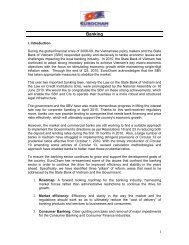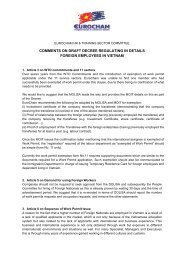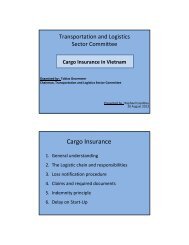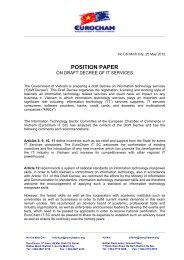ASEAN MUTUAL RECOGNITION ARRANGEMENT ON TOURISM ...
ASEAN MUTUAL RECOGNITION ARRANGEMENT ON TOURISM ...
ASEAN MUTUAL RECOGNITION ARRANGEMENT ON TOURISM ...
Create successful ePaper yourself
Turn your PDF publications into a flip-book with our unique Google optimized e-Paper software.
3.8.1 Recognition of AttainmentIt will be a requirement that any statement of attainment issued by any trainingprovider must be recognised for the purposes of ‘prior standing’ by every othertraining provider within the system regardless of where that training provider islocated and regardless of the perceived reputation of that organisation. This canbe gained in the classroom (Recognition of Prior Learning - RPL) or in theworkplace (Recognition of Current Competence – RCC).3.8.2 Mobility of Career PathwaysThis means that trainees can readily move from (for example) Housekeeping toFront Office or Food and Beverage service, and can move readily from TourOperations to Travel Agencies. The structure also enables trainees to move easilyinto supervisory or managerial qualifications, or retain an operational role withinthe industry while gaining additional skills.3.9 ContextualisationIt is recommended that each Member State adopts and agrees on a common,regional framework both in curriculum and qualifications as the first step beforeconsidering how to integrate CATC with its existing vocational tourism trainingarrangements.3.9.1 Customised by Member StatesCATC can be tailored to suit the individual needs of different Member Statesthrough the way the curriculum is written and interpreted by those who use it. Inpractice, each country can use their own regulations, legislation, codes ofpractice, rules, etc., because of the way the curriculum is written. They can alsomake reference to their own authorities, bodies, agencies and organisations.Providers within each Member State can also tailor units of competency to suittheir specific industry, country or other needs and are free to add their own ‘extracontent’ within any unit they deliver as well as to add extra non-accredited unitsthey deem appropriate or necessary.3.9.2 Local Additions and AmendmentsContextualisation could involve additions or amendments to the unit ofcompetency to suit particular delivery methods, learner profiles, specificenterprise equipment requirements, or to otherwise meet local needs. However,the integrity of the overall intended outcome of the unit of competency must bemaintained.3.9.3 Boundaries of ContextualisationAny contextualisation of units of competency can be done but within the followingboundaries so that providers may:P a g e | 27














